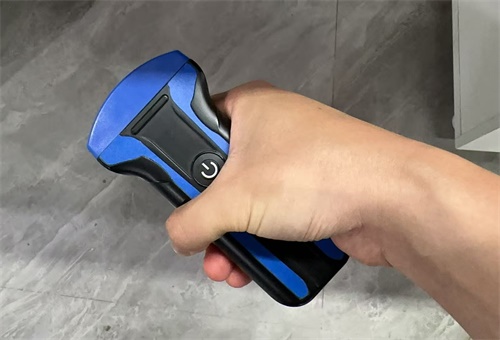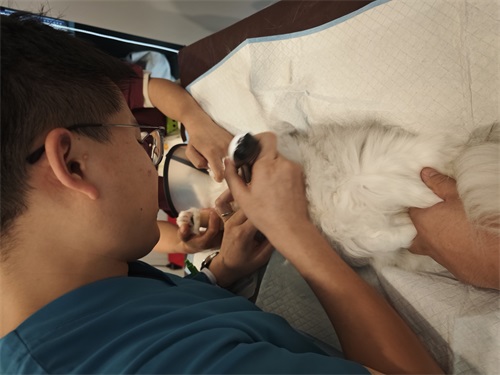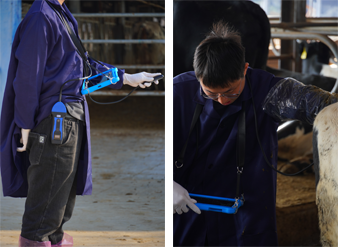Efficient reproduction management is crucial for the profitability of sheep farming. In temperate zones, sheep are typically seasonal breeders, with ewes entering estrus naturally in autumn and early winter. However, driven by market demands and the need for year-round production, more sheep farmers globally—particularly in Australia, New Zealand, and the United States—are turning to out-of-season breeding strategies. A core challenge in such systems is accurate pregnancy detection, especially within the early post-mating window. In this article, we analyze how veterinary ultrasonography (commonly referred to as sheep ultrasound) performs in pregnancy detection between 15 to 60 days post-breeding in ewes during the non-breeding season, comparing it with two other methods: laparoscopic examination and ram marking (ram detection).

Understanding the Reproductive Challenges during the Non-Breeding Season
Sheep are short-day breeders, meaning that their natural estrus cycles are triggered by decreasing daylight. During the non-breeding season (spring and summer in the Northern Hemisphere), ewes are either in anestrus or display weak and irregular heat behaviors. Farmers often apply hormonal treatments to synchronize estrus artificially, using techniques such as Controlled Internal Drug Release (CIDR) and equine chorionic gonadotropin (eCG). While effective, these interventions create atypical reproductive patterns, complicating post-breeding evaluation.
Compounding the issue, rams also exhibit reduced libido and testicular activity during this season due to high temperatures and changing photoperiods. These biological limitations reduce the effectiveness of traditional detection methods, such as using a teaser or fertile ram to identify whether a ewe has returned to estrus.
As such, objective diagnostic tools are essential to determine early pregnancy accurately—allowing farmers to manage nutrition, rebreeding schedules, and culling decisions in a timely manner.
15–25 Days Post-Breeding: Early Stage Challenges
During the first two to three weeks after artificial or natural insemination, detecting pregnancy is notoriously difficult. In non-breeding seasons, this window (15–25 days post-mating) presents compounded difficulties due to physiological irregularities in the ewe.
Ram Detection Method: The simplest approach involves reintroducing a ram to check whether the ewe displays signs of heat again, indicating failed conception. However, in the non-breeding season, the overall detection accuracy for this method hovers around 66%. The reasons are multifactorial:
Rams exhibit low sexual activity.
Ewes may not display visible estrus behaviors even when not pregnant.
Hormonal synchronization sometimes leads to silent estrus or atypical ovarian activity.
As a result, the error rate—both false positives and false negatives—can reach 33%, which is considered unacceptably high in precision-based management systems.
Laparoscopy: Laparoscopic pregnancy diagnosis, although invasive, offers greater accuracy. At 15–25 days, the pregnancy sac is still small, but visual confirmation via the laparoscope yields about 80% accuracy. However, it’s a surgical procedure that requires sedation, skilled personnel, and sterile conditions—making it impractical for large-scale or routine use.
Veterinary ultrasound: Sheep ultrasound (specifically using B-mode scanners with 5–7.5 MHz transducers) achieves approximately 76% accuracy in this time window. Although still challenged by small embryonic vesicles and gas interference from intestines, ultrasound is non-invasive and repeatable. Foreign literature from the U.S. and Europe indicates that this stage is the lower bound of ultrasound’s practical application. Operators must have experience to distinguish early pregnancy sacs from similar structures such as fluid-filled intestines.
Conclusion for This Phase: Laparoscopy offers the highest accuracy but at high cost and logistical complexity. Ultrasound, though slightly less accurate, provides a non-invasive, repeatable, and relatively efficient alternative—already superior to ram detection in both accuracy and practicality.
25–35 Days Post-Breeding: A More Reliable Window
As embryonic development progresses, the size of the gestational sac increases, making it easier to detect using both ultrasound and laparoscopy.
Ram Detection Method: The performance of this method improves slightly as abnormal or silent estrus behavior becomes less common. However, in non-breeding seasons, male libido remains suppressed, and the increase in accuracy is limited—typically reaching 70–75%. False negatives still pose a significant risk.
Laparoscopy: This method continues to perform well, maintaining a consistent 90–92% accuracy rate. By this time, pregnancy sacs are easier to identify, and the presence of active follicles (in non-pregnant ewes) becomes more distinguishable.
Veterinary Ultrasound: In the 25–35 day window, sheep ultrasound achieves around 92–95% accuracy. This is the range where most international veterinary literature supports its widespread use, and it is considered the optimal time for early pregnancy diagnosis in many commercial operations. The interference from intestinal gas or misinterpretation is significantly reduced due to clearer visualization of the uterine structure.
Conclusion for This Phase: Veterinary ultrasound and laparoscopy are now on par in terms of accuracy. However, ultrasound maintains its advantage in being non-invasive and more economically scalable. Ram detection continues to lag due to male reproductive inactivity during this season.
35–45 Days Post-Breeding: Ultrasound Outperforms Laparoscopy
This stage represents the tipping point at which veterinary ultrasound can even outperform laparoscopic diagnosis in certain cases.
Ram Detection Method: By now, the method shows modest improvements in accuracy (76%), but still suffers from significant limitations due to behavior-based detection mechanisms. Foreign researchers, particularly in Australia and Spain, have noted that relying solely on rams during this window leads to high management errors, especially in synchronized flocks.
Laparoscopy: With roughly 92% accuracy, laparoscopy remains reliable. However, a known challenge emerges during this period: some ewes may develop follicular activity alongside a corpus luteum, especially those highly sensitive to hormone induction. This leads to possible misidentification between non-pregnant and early pregnant ovaries.
Veterinary Ultrasound: At this stage, ultrasound reaches 100% accuracy in well-operated hands. The uterus clearly displays pregnancy sacs, and fetal parts or heartbeats may already be visible depending on the device quality. Most importantly, the rate of false positives and false negatives drops dramatically.
Conclusion for This Phase: Ultrasound becomes the gold standard for early pregnancy detection. Its clarity, ease of use, and cost-efficiency make it the method of choice in most modern sheep operations during this window.
45–60 Days Post-Breeding: Peak Accuracy and Stability
As the pregnancy progresses into mid-gestation, the limitations of all diagnostic methods diminish.
Ram Detection Method: Surprisingly, accuracy increases significantly during this time to about 86%. This is primarily due to a partial resurgence of reproductive behavior in both ewes and rams as photoperiods naturally align closer to the breeding season.
However, behavioral inconsistencies still pose risks. From a global perspective, farms relying heavily on ram detection even at this late stage risk mismanaging a portion of their flock.
Laparoscopy: This method achieves near-perfect accuracy (~100%) during this window. Visual confirmation of the fetus and corpus luteum is straightforward, and hormonal abnormalities are minimal.
Veterinary Ultrasound: With high-resolution imaging, ultrasound also hits near-100% accuracy. Fetal movement, size, and placental structures are now clearly visible. More importantly, trained technicians can also assess fetal viability and predict potential embryonic loss.
Conclusion for This Phase: Both laparoscopy and ultrasound are equal in diagnostic performance. However, ultrasound remains the more practical tool due to ease of use, scalability, and safety. It solidifies its place as the optimal pregnancy detection method during the non-breeding season.
Why Foreign Producers Prefer Ultrasound
Globally, countries with advanced sheep industries have adopted ultrasound as the primary method for pregnancy detection, especially outside the natural breeding season. This preference is driven by:
Non-invasiveness: Unlike laparoscopy, ultrasound does not require surgery or sedation.
Reusability: The same machine can be used repeatedly throughout the year and across species.
Cost-effectiveness: Over time, the initial investment is offset by improved reproductive management and reduced labor.
Labor efficiency: A skilled operator can scan 300–600 ewes in a single day.
Versatility: Besides pregnancy, ultrasound can detect uterine infections, ovarian cysts, and other reproductive abnormalities.
Conclusion
In managing sheep reproduction during the non-breeding season, accurate pregnancy detection is crucial for optimizing productivity and resource allocation. While laparoscopic examination provides high accuracy, its invasiveness limits its practical application. Ram detection, although cost-free and traditional, suffers from behavioral and physiological limitations during off-season months.
Veterinary ultrasound strikes a balance—delivering high accuracy, safety, and scalability. Particularly between 25 to 60 days post-breeding, it emerges as the most practical and reliable tool. As sheep producers globally adapt to changing market demands and climate conditions, ultrasound technology will undoubtedly continue playing a central role in reproductive management.
link: https://www.bxlimage.com/nw/1210.html
tags:








